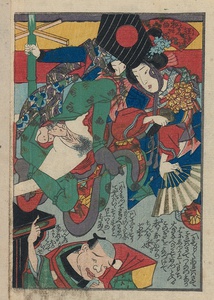| Method | Woodblock (nishiki-e) |
| Artist | Attributed to Utagawa Kunimori II (1827-1899) |
| Published | c. 1850 |
| Dimensions | Chūhon [~180 x 120 mm] |
| Notes |
A rare and unusual comic shunga depicting acrobats having sex on a tight rope while a comic genre figure points at them from below. In this print a male acrobat dressed in a richly patterned costume precariously balances on a tight rope, holding his pole behind him while having sex with a female tight rope walker. The female is dressed as a Sanbasô, a kabuki role, she wears a kago hat with the rising sun and holds a fan. Her winged patterned kimono, with bells on the shoulders, has been lifted and her leg extended, exposing his and her genitalia. Acrobatics were brought to Japan from China in the 600s AD. Initially acrobatics mostly consisted of wire and paper walking. Feats of acrobatics were sponsored by aristocrats and military leaders as a type of religious entertainment and incorporated into kabuki during the Muromachi period (1392–1573). Tightrope or wire walking was referred to as kumomai (spider dancing) and was originally performed by women. With the increased urbanisation in Edo and Kyoto during the Edo period, acrobatics were performed in these urban centres for all classes of society. The joke in this print as with many shunga is multilayered. Karuwaza is the Japanese word for acrobatics and generally refers to juggling, wire walking, tumbling, and perch acrobatics. The word is made of two parts: karu means light or agile and the second kanji waza means "trick"or "business" with secondary meaning "risky business." In this print the act of intercourse is quite literally "risky business" both in and of itself, and doubly so as a feat of literal acrobatics on the tightrope. When juggling and acrobatics were performed in the Edo period they were called hōka which means "release" and something "below" and here the release will be in the act of coitus while we view them from below, a point emphasised by the man pointing from under the acrobats. The costume of the female acrobat also plays its part. She is dressed as a Sanbasô, which is a role that originates from Noh where the actor dances like a marionette. In mid dance, it appears that a string breaks and he begins to dance clumsily. A stage assistant rushes out in a panic to mend it, and the dance continues. The accompany song lyrics celebrate the new year and ask for prosperity, the dance continues and the Sanbasô does a seed sowing dance shaking the bells as if sowing rice along to further sexually suggestive lyrics. In this print, the parallels of coitus and rice sowing are meant to add a further layer of sexual joke and pun. Shunga is the term used for the body of erotic imagery produced in Japan from 1600 to 1900. The term shunga means spring pictures, a euphemism for sex, and is one of several names for erotic material produced in Japan. Shunga took different formats: painted hand scrolls, painted books, printed books and albums, and sets of prints which were sometimes sold in wrappers. As prints they are one of the genres of ukiyo-e, or Floating World prints, which also include fukeiga (landscape prints), and bijin-ga (prints of beautiful women). Most of the major ukiyo-e artists produced shunga material at some point during their careers, including Utamaro (who produced more erotic books than non-erotic books), Hokusai, and Hiroshige. Produced at the same time as the introduction of full colour woodblock printing, shunga prints and books were made using the most lavish and complicated printing techniques, including gauffrage, metallic inks, mica, complicated printed patterns, and multicolour printing using a high number of different colours. Although prolific in its number and variety, shunga should be seen as more representative of the ideals of the ukiyo, with its emphasis on mutual pleasure, rather than as an accurate representation of Japanese attitudes and practices of sexuality. Shunga present an invitation to pleasure through the bliss of lovemaking and though largely heteronormative, they portray the full gamut of couplings, married or otherwise, often surrounded by lavish settings and objects of pleasure. Utagawa Kunimori II (1827-1899) was an Edo print maker and a pupil of Utagawa Kunisada. Ex. Col.: Peter Darach Reference: Rudlin, Pernille. The origins of acrobatics (karuwaza) in Japan. Digital museum of Japan-UK show business. https://ninjin.co.uk/2022/06/20/the-origins-of-acrobatics-karuwaza-in-japan/" Condition: Binding holes in margin as issued. |
| Framing | mounted |
| Price | £250.00 |
| Stock ID | 53252 |

